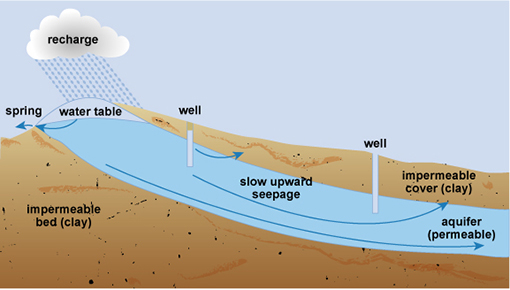4.3.2 Groundwater
An aquifer is an underground layer of water-bearing rock.Water-bearing rocks are permeable, meaning that liquids and gases can pass through them. Groundwater is the water contained in aquifers (Figure 4.7). This is replenished or recharged by precipitation that percolates through the soil to the water table, and by water seeping from streams, as well as other bodies of surface water, such as lakes and wetlands.

The water table is the top of the groundwater below the land surface. Its level fluctuates seasonally and from year to year as the inputs from precipitation and the outputs vary. The depth of the water table also varies with location, from being near to the land surface in areas close to surface water bodies and in humid climates, to being hundreds of metres below the land surface in drier regions.
Groundwater reaches the surface naturally through springs or artificially through wells. Springs typically rise up where the water table meets the land surface. Springs are important sources of water to feed streams and are attractive cultural and landscape features in themselves. Wells and boreholes are dug by hand or drilled by machine. These have to be deep enough to extend below the water table so that water can be drawn up by bucket or by pumping.
4.3.1 Surface water
